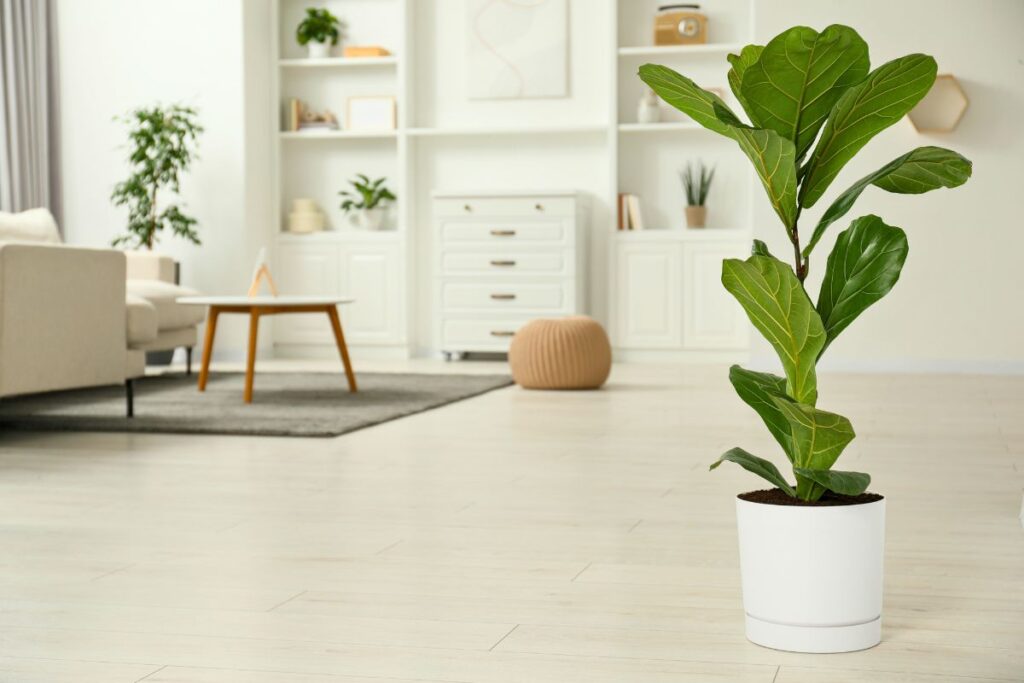Fiddle leaf figs, with their large, violin-shaped leaves and striking appearance, have become a popular choice for indoor gardeners. These statement plants can add a touch of elegance to any room, but they do require some specific care to thrive. This comprehensive guide will provide you with everything you need to know about indoor care for fiddle leaf figs, ensuring they remain healthy and vibrant all year round.

Contents
Understanding Fiddle Leaf Figs
Fiddle leaf figs (Ficus lyrata) are native to the tropical rainforests of West Africa. They are part of the Moraceae family and are known for their large, glossy leaves that can grow up to 12 inches long. Fiddle leaf figs can reach heights of up to 10 feet or more indoors, making them a dramatic and eye-catching addition to your home.
Light Requirements
Fiddle leaf figs thrive in bright, indirect light. They can tolerate some direct sunlight, especially in the morning or late afternoon, but excessive direct sunlight can scorch their leaves. Place your fiddle leaf fig near a south or east-facing window where it can receive plenty of bright, filtered light. If natural light is insufficient, you can supplement with artificial grow lights to ensure your plant gets the necessary light.
Watering Routine
Proper watering is crucial for the health of fiddle leaf figs. These plants prefer their soil to be kept consistently moist but not soggy. Use a well-draining soil mix and a pot with drainage holes to prevent water from sitting at the bottom. Water your fiddle leaf fig thoroughly when the top 1-2 inches of soil are dry. Reduce watering during the winter months when the plant’s growth slows down. Overwatering can lead to root rot, which is a common issue with fiddle leaf figs.
Humidity and Temperature
Fiddle leaf figs thrive in environments with moderate to high humidity. To maintain the necessary humidity levels, you can use a humidifier, place a tray of water near the plant, or mist the leaves regularly. Ideally, humidity levels should be around 40-60%.
When it comes to temperature, fiddle leaf figs prefer a warm environment. They thrive in temperatures between 65-75°F (18-24°C). Avoid placing your fiddle leaf fig near drafts, air conditioners, or heaters, as sudden temperature changes can stress the plant.
Soil and Fertilization
Fiddle leaf figs prefer a well-draining soil mix. A combination of potting soil, peat moss, and perlite works well. This mix ensures good aeration and prevents the soil from becoming waterlogged. It’s also a good idea to repot your fiddle leaf fig every 1-2 years to refresh the soil and provide more space for root growth.
Fertilize your fiddle leaf fig during the growing season (spring and summer) with a balanced liquid fertilizer diluted to half strength. Fertilize once a month to promote healthy growth and vibrant foliage. Avoid fertilizing during the fall and winter months when the plant’s growth slows down.
Pruning and Training
Pruning your fiddle leaf fig helps maintain its shape and encourages bushier growth. Remove any dead or yellowing leaves and trim back leggy branches to promote new growth. Fiddle leaf figs can be trained to grow in a desired shape by gently bending and tying branches. Regularly inspect your plant for pests such as spider mites, scale, and mealybugs, which can damage the leaves and stems.
Propagation
Fiddle leaf figs can be propagated through stem cuttings. To propagate, follow these simple steps:
- Select a healthy stem with at least one leaf and a node (the point where a leaf attaches to the stem).
- Cut the stem just below the node using a clean, sharp pair of scissors or pruning shears.
- Remove the lower leaves, leaving at least one leaf at the top.
- Dip the cut end in rooting hormone to encourage root growth (optional).
- Place the cutting in a small pot filled with a well-draining soil mix or a jar of water.
- Keep the soil moist (if using soil) or change the water regularly (if using water).
- Place the cutting in a warm, bright location with indirect light.
- Within a few weeks, roots should develop, and new growth will appear.
Once the cutting has established roots, you can transplant it into a larger pot and care for it as you would a mature fiddle leaf fig.
Common Problems and Solutions
Yellow Leaves
Yellow leaves can be a sign of overwatering, underwatering, or a nutrient deficiency. Check the soil moisture and adjust your watering routine accordingly. If the problem persists, consider fertilizing your fiddle leaf fig to provide the necessary nutrients.
Leaf Drop
Leaf drop can occur due to sudden changes in light, temperature, or humidity. Ensure your fiddle leaf fig is in a stable environment with consistent conditions. Avoid moving the plant frequently and provide adequate light and humidity.
Pests
Common pests that affect fiddle leaf figs include spider mites, scale, and mealybugs. Regularly inspect your plant and treat any infestations with insecticidal soap or neem oil. Isolate affected plants to prevent the pests from spreading to other houseplants.
Conclusion
Fiddle leaf figs are a stunning addition to any indoor garden, offering large, glossy leaves and an impressive stature. By providing the right light, water, humidity, and care, you can ensure your fiddle leaf fig thrives and remains healthy. With a bit of attention and patience, you’ll be rewarded with a beautiful and vibrant plant that will bring a touch of elegance to your home.
